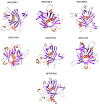Genome-Wide Identification and Evolutionary Analysis of Gossypium Tubby-Like Protein (TLP) Gene Family and Expression Analyses During Salt and Drought Stress
- PMID: 34367198
- PMCID: PMC8335595
- DOI: 10.3389/fpls.2021.667929
Genome-Wide Identification and Evolutionary Analysis of Gossypium Tubby-Like Protein (TLP) Gene Family and Expression Analyses During Salt and Drought Stress
Abstract
Tubby-like proteins (TLPs) possess a highly conserved closed β barrel tubby domain at C-terminal and N-terminal F-box. The role of TLP gene family members has been widely discussed in numerous organisms; however, the detailed genome-wide study of this gene family in Gossypium species has not been reported till date. Here, we systematically identified 105 TLP gene family members in cotton (Gossypium arboreum, Gossypium raimondii, Gossypium hirsutum, and Gossypium barbadense) genomes and classified them into eight phylogenetic groups. Cotton TLP12 gene family members clustered into two groups, 4 and 8. They experienced higher evolutionary pressure in comparison to others, indicating the faster evolution in both diploid as well as in tetraploid cotton. Cotton TLP gene family members expanded mainly due to segmental duplication, while only one pair of tandem duplication was found in cotton TLPs paralogous gene pairs. Subsequent qRT-PCR validation of seven putative key candidate genes of GhTLPs indicated that GhTLP11A and GhTLP12A.1 genes were highly sensitive to salt and drought stress. The co-expression network, pathways, and cis-regulatory elements of GhTLP11A and GhTLP12A.1 genes confirmed their functional importance in salt and drought stress responses. This study proposes the significance of GhTLP11A and GhTLP12A.1 genes in exerting control over salt and drought stress responses in G. hirsutum and also provides a reference for future research, elaborating the biological roles of G. hirsutum TLPs in both stress responses.
Keywords: expression; genome-wide analysis; network; phylogenetic analysis; salt and drought stress responses; transcription factor.
Copyright © 2021 Bano, Fakhrah, Mohanty and Bag.
Conflict of interest statement
The authors declare that the research was conducted in the absence of any commercial or financial relationships that could be construed as a potential conflict of interest.
Figures







Similar articles
-
Tubby-like proteins (TLPs) transcription factor in different regulatory mechanism in plants: a review.Plant Mol Biol. 2022 Dec;110(6):455-468. doi: 10.1007/s11103-022-01301-9. Epub 2022 Oct 18. Plant Mol Biol. 2022. PMID: 36255595 Review.
-
Genome-wide identification and expression analysis of the HD2 protein family and its response to drought and salt stress in Gossypium species.Front Plant Sci. 2023 Feb 13;14:1109031. doi: 10.3389/fpls.2023.1109031. eCollection 2023. Front Plant Sci. 2023. PMID: 36860898 Free PMC article.
-
Genome-wide analysis of the MADS-box gene family in polyploid cotton (Gossypium hirsutum) and in its diploid parental species (Gossypium arboreum and Gossypium raimondii).Plant Physiol Biochem. 2018 Jun;127:169-184. doi: 10.1016/j.plaphy.2018.03.019. Epub 2018 Mar 20. Plant Physiol Biochem. 2018. PMID: 29604523
-
Genome-wide comparative analysis of NBS-encoding genes in four Gossypium species.BMC Genomics. 2017 Apr 12;18(1):292. doi: 10.1186/s12864-017-3682-x. BMC Genomics. 2017. PMID: 28403834 Free PMC article.
-
Genome-Wide Analysis of the NF-YB Gene Family in Gossypium hirsutum L. and Characterization of the Role of GhDNF-YB22 in Embryogenesis.Int J Mol Sci. 2018 Feb 6;19(2):483. doi: 10.3390/ijms19020483. Int J Mol Sci. 2018. PMID: 29415481 Free PMC article.
Cited by
-
Tubby-like proteins (TLPs) transcription factor in different regulatory mechanism in plants: a review.Plant Mol Biol. 2022 Dec;110(6):455-468. doi: 10.1007/s11103-022-01301-9. Epub 2022 Oct 18. Plant Mol Biol. 2022. PMID: 36255595 Review.
-
Characterization and Expression Analysis of the PvTLP Gene Family in the Common Bean (Phaseolus vulgaris) in Response to Salt and Drought Stresses.Int J Mol Sci. 2025 Jun 13;26(12):5702. doi: 10.3390/ijms26125702. Int J Mol Sci. 2025. PMID: 40565168 Free PMC article.
-
Genome-Wide Identification, Characterization, and Expression Analysis of Tubby-like Protein (TLP) Gene Family Members in Woodland Strawberry (Fragaria vesca).Int J Mol Sci. 2022 Oct 8;23(19):11961. doi: 10.3390/ijms231911961. Int J Mol Sci. 2022. PMID: 36233267 Free PMC article.
-
Identification of miRNA and their target genes in Cestrum nocturnum L. and Cestrum diurnum L. in stress responses.Physiol Mol Biol Plants. 2022 Jan;28(1):31-49. doi: 10.1007/s12298-022-01127-1. Epub 2022 Feb 4. Physiol Mol Biol Plants. 2022. PMID: 35221570 Free PMC article.
-
Molecular analyses of the tubby-like protein gene family and their response to salt and high temperature in the foxtail millet (Setaria italica).Funct Integr Genomics. 2024 Sep 25;24(5):170. doi: 10.1007/s10142-024-01458-0. Funct Integr Genomics. 2024. PMID: 39317784
References
-
- Ali F., Qanmber G., Wei Z., Yu D., Hui Li Y., Gan L., et al. . (2020). Genome-wide characterization and expression analysis of geranylgeranyl diphosphate synthase genes in cotton (Gossypium spp.) in plant development and abiotic stresses. BMC Genomics, 21:561. 10.1186/s12864-020-06970-8 - DOI - PMC - PubMed
LinkOut - more resources
Full Text Sources

